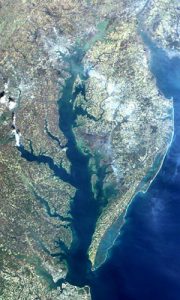 Tides and currents are vital components of the Chesapeake Bay ecosystem. These movements of the water have considerable impacts on fish, aquatic plants, and other bay life. Although tides and currents are most often associated with oceans, and bays, their effects can be detected throughout the rivers and creeks that empty into the Chesapeake. In addition to tides and currents, stratifications and inversions are factors that can affect the bay waters.
Tides and currents are vital components of the Chesapeake Bay ecosystem. These movements of the water have considerable impacts on fish, aquatic plants, and other bay life. Although tides and currents are most often associated with oceans, and bays, their effects can be detected throughout the rivers and creeks that empty into the Chesapeake. In addition to tides and currents, stratifications and inversions are factors that can affect the bay waters.
Tides
Tides are complex movements of water that involve hundreds of variables. The most important element of tides is the movement of the moon around the Earth. The moon’s gravity pulls water from place to place as it circles the planet.
Currents
Currents are caused by gravity, tides or the motion of bodies of water. In the Chesapeake Bay, currents may occur in phase with tides or may be offset by a considerable amount.
Saltwater – Freshwater Collisions
Often two or more bodies of water having different salinity levels converge in the bay. Although some mixing occurs, a certain amount of stratification (layering) may also occur. On the surface this may be very confusing to boaters and fishermen. Saltwater is heavier and tends to sink when it meets a body of freshwater. The result can make surface waters appear to be running “out” when in fact the tide is rising. Temperature breaks often occur when currents collide in the Chesapeake.
Wind Currents
As wind move over a body of water, waves are created. This causes water on the surface to move in the direction of the wind. Water that is driven by the wind must be displaced, so the water from bottom rises up to fill the void. The process continues which can cause considerable mixing.
Stratification
Stratification occurs when bodies of water have significant differences in temperature. The cooler water sinks while the warmer water rises, creating two or more distinct environments.
Temperature Inversions
Temperature inversions can occur in the bay during spring and fall. When the temperature of an upper layer becomes cooler than a layer below it, inversion may occur. In fall, cool surface waters sink as warmer waters from below move to the surface.